Lecture Notes Shakespeare I Sonnet
- 格式:doc
- 大小:49.50 KB
- 文档页数:3
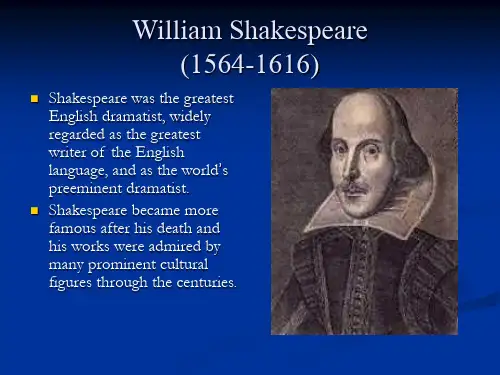
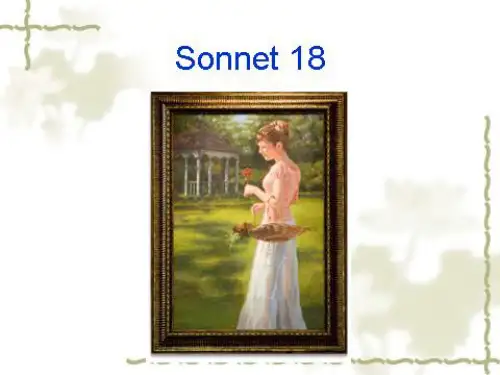
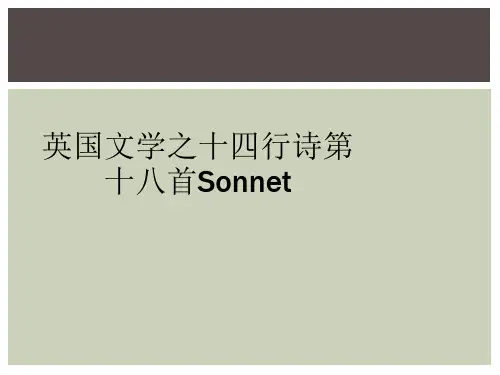
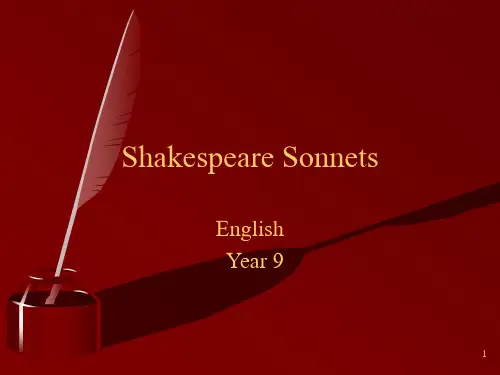
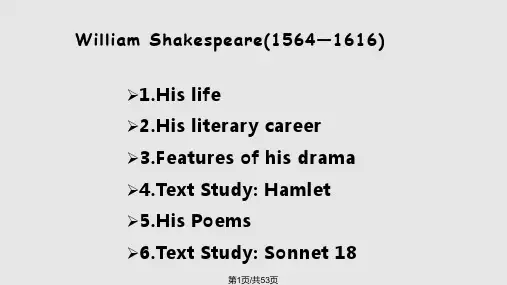
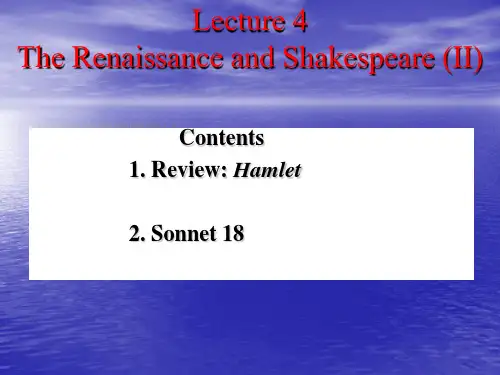
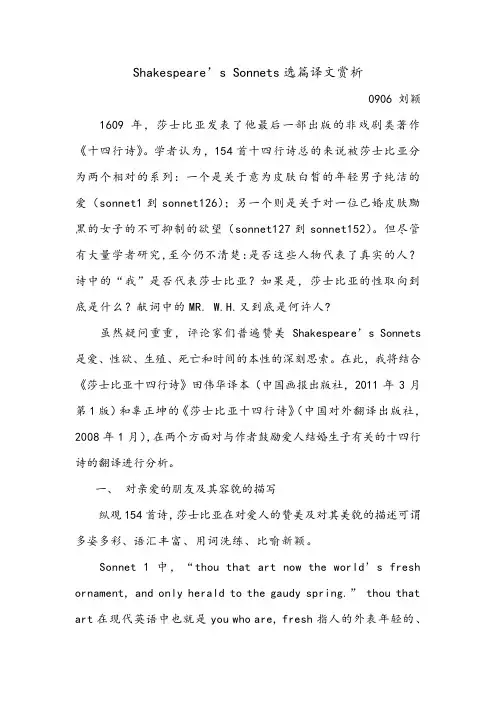
Shakespeare’s Sonnets选篇译文赏析0906 刘颖1609年,莎士比亚发表了他最后一部出版的非戏剧类著作《十四行诗》。
学者认为,154首十四行诗总的来说被莎士比亚分为两个相对的系列:一个是关于意为皮肤白皙的年轻男子纯洁的爱(sonnet1到sonnet126);另一个则是关于对一位已婚皮肤黝黑的女子的不可抑制的欲望(sonnet127到sonnet152)。
但尽管有大量学者研究,至今仍不清楚:是否这些人物代表了真实的人?诗中的“我”是否代表莎士比亚?如果是,莎士比亚的性取向到底是什么?献词中的MR. W.H.又到底是何许人?虽然疑问重重,评论家们普遍赞美Shakespeare’s Sonnets 是爱、性欲、生殖、死亡和时间的本性的深刻思索。
在此,我将结合《莎士比亚十四行诗》田伟华译本(中国画报出版社,2011年3月第1版)和辜正坤的《莎士比亚十四行诗》(中国对外翻译出版社,2008年1月),在两个方面对与作者鼓励爱人结婚生子有关的十四行诗的翻译进行分析。
一、对亲爱的朋友及其容貌的描写纵观154首诗,莎士比亚在对爱人的赞美及对其美貌的描述可谓多姿多彩、语汇丰富、用词洗练、比喻新颖。
Sonnet 1中,“thou that art now the world’s fresh ornament, and only herald to the gaudy spring.” thou that art在现代英语中也就是you who are, fresh指人的外表年轻的、健康的,herald是使者的意思。
因此,田伟华先生译为“你是当今世界最新鲜的装饰品,你是灿烂春天里的唯一信使”文采与感情兼具。
Sonnet 2中,“when forty winters shall besiege thy br ow, and dig deep trenches in thy beauty’s field”这里的besiege指“包围”,可知作者在1、2行将岁月侵蚀美貌进行军事比喻,因此喻指皱纹的trenches译为“战壕”更合适。
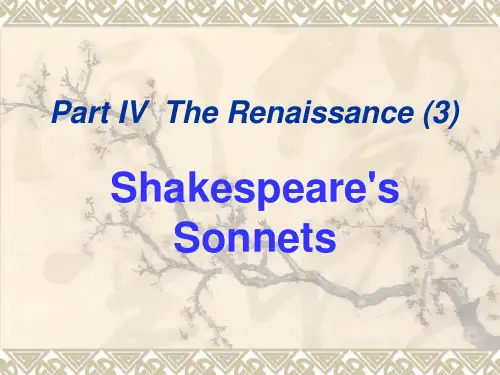
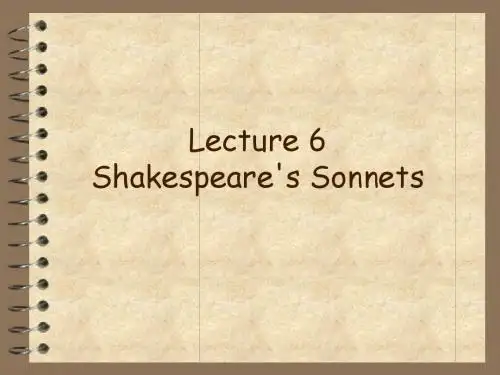
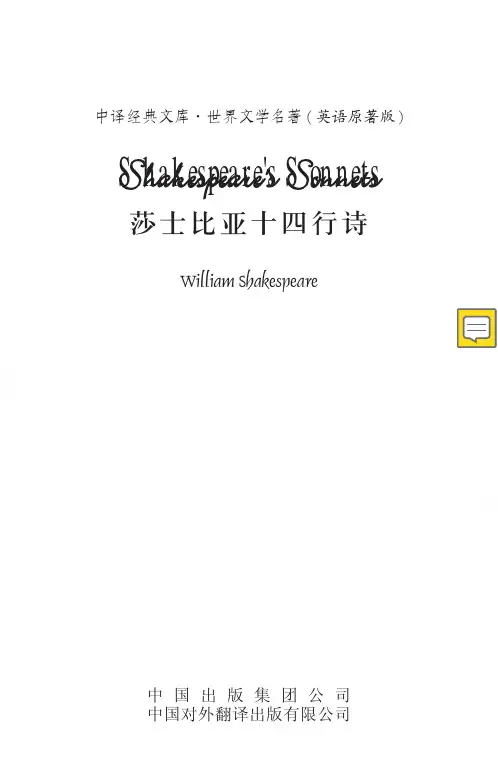

- 248-校园英语 / 文艺研究A Study of Shakespeare’s Tone in Sonnet 35云南大学/谢青 张耀莎A S t u d y o f S h a k e s p e a r e’s To n e i n S o n n e t35 Sonnet 35 grows from a comforting tone to a slightly blaming tone and ends with a forgiving tone, reflecting the speaker’s inner contradiction and tolerance, as well as his deep love for the listener. In this sonnet, it is known that the listener does wrong to the speaker and hurts him badly. However, keeping his own grief bottled up and trying his best to find excuses for the listener’s wrong doings, the speaker comforts the listener patiently and tolerantly who is shedding his tears in pain. The speaker’s mixed love-hate feelings are made plain in comforting comparisons, negative words, and final forgiveness.In order to wash away the listener’s sins, the speaker comforts him with comparisons in the first quatrain.No more be grieved at that which thou hast done;Roses have thorns, and silver fountains mud,C l o u d s a n d e c l i p s e s s t a i n b o t h m o o n a n d s u n, And loathsome canker lives in sweetest bud. (1-4)In the first line, the speaker directly comforts the listener not to be so grieved at what he has done and comes up with examples to demonstrate that nothing is perfect enough without stains in a very comforting tone. Roses are beautiful but they are stained by annoying thorns; fountains are clean but they cannot exist without mud; the moon and the sun are bright but they are sometimes dimmed by clouds and eclipses; even the sweetest bud which seems to be perfect is inevitably spotted by loathsome cankers. Actually the speaker uses such images as roses, fountains, the moon, the sun, and the sweetest bud on purpose. The speaker aims to use them to embody the listener’s beauty, which implies the speaker’s love for the listener.Apart from using comparisons with things in nature to wash away the listener’s stains, the speaker continues to point out that to err is human and no one is exceptional, as the following line shows:All men make faults, and even I in this, (5)But in the next line the tone is changed to a slightly blaming one, as the following lines shows:Authorizing thy trespass with compare,Myself corrupting salving thy amiss,Excusing thy sins more than thy sins are;(6-8)For to thy sensual fault I bring in sense;Thy adverse party is thy advocate,And ‘gainst myself a lawful plea commence.Such civil war is in my love and hate. (8-12)The speaker shows his mixed love-hate feelings under the skin by using some negative words in a wonderful way as we can see in above lines. Obviously, words like “trespass”, “amiss”, “sins”, “fault”, “adverse”, “war” and “hate” reflect how badly the listener has done to the speaker and convey the speaker’s complaints and distress in a slightly blaming tone. In a normal case, the speaker should severely fight against the listener for his despicable deeds because he robs the mistress of the speaker. Needless to say, the speaker is hurt and grieved due to his deeds. On the one hand, the speaker considers the listener’s deed sinful and faulty, and he as the adverse party has every reason to blame him. On the other hand, the speaker can not bear watch the listener weep all the time without any mercy, so he corrupts himself and fights against himself to find any excuse to defend the listener’s deeds. From that we can know that there is a fierce war in the speaker’s inner world where the one betrayed by listener is defeated by the one who deeply loves the listener.After painful struggles inside, the speaker forgives the listener in the final couplet:That I an accessary needs must beTo that sweet thief which sourly robs from me. (13-14)Although the listener robs the mistress of the speaker, which hurts the speaker’s feelings badly, the speaker finally chooses to cover up the listener’s sins and to defend him. The speaker is going to be the accomplice rather than the plaintiff. The change of roles implies that the speaker forgives the listener. Another implication is showing when the speaker calls the listener “sweet thief” that the speaker loves the listener so much that he chooses to forgive him no matter how bad his doings are.In summary, the speaker’s mixed love-hate feelings and tolerant love for the listener are embodied by comparisons in a comforting tone, negative words a blaming tone, and final forgiveness a forgiving tone.References:[1]Shakespeare,William.Shake-speares Sonnets:Never Before Imprinted.London:Thomas Thorpe,1609.Copyright©博看网 . All Rights Reserved.。
Part II
The English Renaissance
The Renaissance
A series of literary and cultural movements
Began in the 14th century in Italy, and eventually expanded into Germany, France,
England and other parts of Europe
∙Florence– the cradle of Renaissance
Renaissance – a French word which means “rebirth” in English, the rebirth of letters
Characteristics
•Rediscovery of classical Greek and Latin literature and art
•Humanism人文主义– the ideal and essence of the Renaissance
▪The admiration for human beauty and human achievements
▪The emphasis on the unique talents, potentials and the worth of the individual
▪A feeling in sharp contrast to Medieval theology
The English Renaissance
Historical Background
•The peaceful and prosperous time during the reign of Queen Elizabeth (1558-1603)•The Enclosure Movement 圈地运动
-- Two opposite classes came into being: the capitalist class and the labouring class Time
•From the late 15th century to the early 17th century
The greatest accomplishments of the English Renaissance were in literature
Poetry: Edmund Spencer(The Faerie Queene, 埃德蒙·斯宾塞《仙后》), Philip
Sydney (Astrophel and Stella, 菲利普·锡德尼《爱星者与星》), William Shakespeare Drama–the highest glory of English Renaissance: William Shakespeare,
Christopher Marlowe(克里斯托弗·马洛), Ben Jonson(本·琼生);
Prose: Thomas More (Utopia 托马斯·莫尔《乌托邦》), Francis Bacon(弗朗西斯·培
根)
William Shakespeare (1564-1616) 威廉·莎士比亚
I. Life and Career
His birth and family
His education
His marriage
His London life
His death
II. Literary Achievements
Shakespeare’s complete works:
∙37 plays
∙ 2 narrative poems
∙154 sonnets
Shakespeare’s Sonnets
1. Sonnets (十四行诗/商赖诗)
• A poem in 14 lines
•Originated in Italy, a form very popular in Renaissance Europe, especially in Italy, France and England
•Introduced to England by Thomas Wyatt (怀亚特) and the Earl of Surrey (塞莱)
The Italian or Petrarchan sonnet 意大利型或彼得拉克型十四行诗
•The first eight lines –octave, the theme is put forward or a question is raised
•The next six lines –sestet, the answer to the theme
•Rhyme scheme (the use of similar sounding words in poetry 韵律格式): abba abba cdc dcd (cde cde)
The Shakespearian or English sonnet 莎士比亚型或英国十四行诗:
•Three quatrains (四行诗) – the theme is put forward and developed
•The couplet (两行诗)– a surprising conclusion or a shift of ideas
•Rhyme scheme: abab cdcd efef gg
2. Shakespeare’s sonnets: 154 sonnets
•Sonnets 1-126: addressed to a young man
•Sonnets 127-152: addressed to “Dark Lady”
•Sonnets 153-154: addressed to Cupid, the God of love in Greek mythology
Sonnet 18
Thou – you (subjective case)
Thee – you (objective case)
Thy – your
Thine – yours
Discussions
* What rhetorical devices are used by the poet?
* What do you think is the theme of this sonnet?
Theme
•To praise the beauty of the young man
•Transience of beauty in nature
•Immortality of art in general (poetry in particular)。